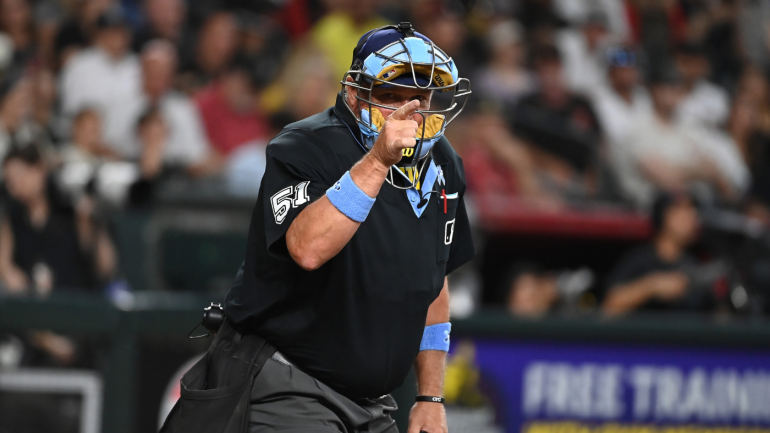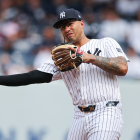
For some time now, an automated strike zone -- informally known as the "robo ump" -- has been used at the Triple-A level and on occasion at various other rungs of the minor leagues. Recently, MLB announced plans to use one variation of the automated ball-strike (ABS) system, the challenge system, in all remaining Triple-A games, beginning June 25. Likely, this signifies that the ABS challenge system will eventually be used in the majors.
This would amount to one of the most drastic structural changes to the major-league game in some time, and it likely leaves fans with questions about what the ABS system is, how it works, and what it'll be like to see it in action. What follows is our attempt to answer those questions that might be bubbling up in your mind when you ponder the future of the strike zone.
How is it possible to automate the strike zone?
The ABS system utilizes a Hawk-Eye camera technology to determine whether each pitch is in or out of a strike zone that's tailored to each hitter. Here's a generalized 2021 explanation from three engineers who have worked on the system in use:
The ABS system design has four discrete subsystems:
- The MLB tracking system;
- An interface the ballpark operator uses to set the correct batter;
- An MLB server that receives the tracking data and has the ball-strike evaluation code;
- A low-latency communication system to relay calls to the umpire.
As for the strike zone, as noted it's player-specific, which means that, say, Aaron Judge and Jose Altuve would not have the same zone parameters. That even means that Dansby Swanson and Tim Anderson -- each listed at 6-foot-1 -- would not have the same zones because of stance differences. So, no, this is not the rudimentary (and occasionally misleading) zone you're accustomed to seeing during televised games. Here's what Baseball America's J.J. Cooper reported in August of last year about the latest round of ABS system zone refinements:
"Now, the ABS system will use the Hawk-Eye system's visual tracking to set the Triple-A strike zone. Since the Hawk-Eye system tracks each player's limbs, the strike zone will now be set individually for each player. The system will set the bottom of the strike zone at a player's knees. For the top of the zone, the strike zone will be set as two baseballs above the midpoint of the measurements of a player's left and right hips. That's aimed to put the top of the zone near the belt-line.
"The new zone will mean each player's strike zone is uniquely tied to their body and stance rather than a universal formula. The new strike zone is hoped to more closely resemble the strike zone used by human umpires, although the top end is still designed to be lower than the top end of the MLB strike zone."
That level of individualizing is necessary to make an automated zone fair to all hitters, and what's described above achieved that quite well.
Why is an ABS system needed?
It's deemed increasingly necessary because plate umpires have an increasingly difficult job. The average big-league fastball measures 94.1 mph and is speeding up every year. You'll see plenty of hard, late-breaking sliders and even some changeups that reach the plate as rapidly as the four-seamers of a generation ago. Throw in the emphasis on pitch-framing, in which catchers across the league are more adept than ever at deceiving umpires, and you've made the job of calling balls and strikes something close to impossible. That's especially the case when it comes to borderline pitches.
For instance, pitches on the corners taken by the hitter have been called accurately by the plate umpire just 58.7% of the time, according to TruMedia data. In two-strike counts, umps call pitches on the corners correctly just 46.3% of the time. All the missed calls are unfair to players and fans, and asking umpires to continue attempting the impossible is unfair to them. That's why an ABS system is needed in MLB.
What's the difference between a challenge system and a full ABS system?
In a full ABS system, every ball-strike call is automated, and the human ump is there to relay those automated calls provided via earpiece and perform other duties (safe-out calls at the plate, balks and catcher's interference, checked-swing calls, and so forth). Even with the full system, the ump must still mentally make his or her own ball-strike calls in case the automated system suffers some kind of glitch and is unable to make ball-strike determinations.
Under the challenge system, the human umpire will be discerning balls and strikes on all pitches. However, the pitcher, batter, or catcher has the right to "challenge" calls they think were missed. At that point, the ABS system decides whether the challenged ball-strike call is correct or overturned. In order to prevent indiscriminate challenges, each team receives a limited number of incorrect challenges per game -- say, three. If your challenge results in an overturn, you keep it. There's incentive to be judicious with challenges, lest you lose them all in the early innings.
How will this work in practice?
Perhaps a video demonstration is in order. Regard:
I still don’t understand why MLB isn’t implementing this in the major leagues this season pic.twitter.com/1CTNObnFMu
— Dom (@BronxBmbrz) February 10, 2024
As you can see, the batter challenges the strike call by physical signal (tapping his helmet), and the plate ump relays the challenge request and receives the correct call. It all happens quickly and about as seamlessly as possible.
How soon will there be an ABS system at the big-league level?
Here's what MLB commissioner Rob Manfred said back in May about a potential timeline:
"We still have some technical issues; I don't mean technology, I mean technical issues in terms of the operation of the system. We haven't made as much progress in the Minor Leagues this year as we hoped at this point. I think it's becoming more and more likely that this will not be a go for '25."
That means you're not likely to see an ABS system in the major leagues until 2026 at the earliest. Until then, may the strikes be called strikes.


















